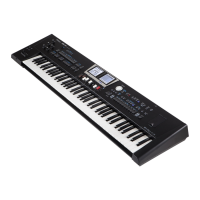Rhythm Composer
114
Parameter Setting Explanation
Track ADrums~Acc6, ALL
Allows you to select the track you wish
to edit. You can also select “ALL” here,
in which case the operation applies to
all tracks.
Mode Major, Minor, 7th,
Allows you to select the Mode to be
edited.
Division
Intro 1~4, Main 1~4,
Fill Dwn 1~3, Fill Up
1~3, End 1~4
Use this parameter to select the
Division you want to edit.
From Bar
For the settings and explanation see page 109.
From Beat
From CPT
To Bar
To Beat
To CPT
Bias –1920~1920
This parameter sets the amount by
which the duration (or gate time) of
the selected notes is to change. The
shortest possible “Gate Time” value is
“1” (used for all drum notes), so that
selecting “–1000” for notes with a “Gate
Time” value of “1” in the specied time
range still leaves you with the same
value.
Magnify 0~200%
Use this parameter rather than “Bias” to
produce proportional changes to the
aected “Gate Time” values. Values
below “100%” decrease the duration,
while anything above “100%” increases
it. Select “100%” if you prefer to work
with the “Bias” parameter (see above).
From Note/
To Note
0 C-~127 G9
“From Note” refers to the lower limit of
the note range you want to change. “To
Note” represents the upper limit.
2. Press the [WRITE] button (its indicator ashes) to conrm
your settings and edit the data.
The display briey conrms the operation and then returns to the
current Composer page.
Global Change
This function allows you to make quick changes to certain settings.
The changes always apply to entire tracks (you cannot use “Global
Change” for just a few measures). You can apply global changes
to the four editable rhythms track parameters (“Express”, “Reverb”,
“Panpot” and “Chorus”) when you notice that the eect is too
prominent or not strong enough.
You can also use it to “upgrade” older rhythms to ensure that they
use theBK-9’s new sounds.
Right Display
1. Use the dial to edit the following parameters.
Parameter Setting Explanation
Track ADrums~Acc6, ALL
Allows you to select the track you wish
to edit. You can also select “ALL” here,
in which case the operation applies to
all tracks.
Mode Major, Minor, 7th, ALL
Allows you to select the Mode to be
edited.
Division
Intro 1~4, IntroALL,
Main 1~4,
Fill Dwn 1~3,
Fill Up 1~3,
End 1~4, ALL
Use this parameter to select the
Division you want to edit.
Alteration
Mode*
Nearest, Degree, --
This message type is only available
for melodic rhythm tracks (i.e. not
for ADrums or ABass tracks). Rhythm
tracks you only just recorded do not
contain it..
• Nearest**: Refers to a more musical
system for real-time shifts of the
recorded rhythm notes during
Arranger playback. See p. 117.
• Degree: This setting refers to the
“old” system for real-time conversion
of track information during rhythm
playback. See p. 117.
• Select “---” if the selected pattern
should ignore this setting.
From/To…
CC00, CC32,
PC
---, 0~127, ALL
1~128
Enter the original data value (i.e. the
value that is being used right now by
the selected track(s)) for “From”. For
“To”, specify the new value that should
replace the “From” value. These are what
we call “absolute” changes: you don’t
add or subtract values, you replace
them with other values. This system is
only available for messages that allow
you to select sounds or sound banks.***
Inc/Dec…
Expression,
Reverb,
Chorus,
Panpot
–127~127
These parameters allow you to add (+)
or subtract (–) a given value to/from
the current Expression, Pan, Reverb
Send or Chorus Send values. This may
come in handy if the real-time changes
you recorded turn out to be too high
or too low.
[*] This parameter is not available for: ADrums and ABass tracks,
Intro3 & 4 and End3 & 4 patterns.
[**] The notes of the melodic rhythm tracks are compared against
the chords played in the recognition area. If the next chord you play
contains the note the selected part is already sounding (based on
the previous chord), that note is maintained. If the new chord does
not contain that note, the rhythm part in question uses the closest
(“Nearest”) note. This produces a more musical behavior than any
other system on the market.
[***] CC00 messages are the so-called “MSB” bank select messages.
They allows you to select the Capital Tone (select “0”) of a sound
address. Select “---” if the current setting must not change. The
CC32 control change is the so-called “LSB” bank select message.
Use the PC parameter to change the address, a.k.a. program change
number, of a sound (e.g. from “1” to “2”).
2. Press the [WRITE] button (its indicator ashes) to conrm
your settings and edit the data.
The display briey conrms the operation and then returns to the
current Composer page.

